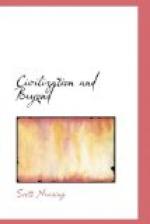Social planning at the planetary level could deal chiefly with large national or regional groupings, more or less divergent in viewpoint but conscious of the necessity for bringing local and regional groups together in order to secure common agreement and to take part in directed joint actions. Such efforts must aim at sufficient cohesion to provide for normal social function at all levels; sufficient permissiveness to allow for a measure of self-determination at all levels; sufficient authority to carry on production and distribution at all levels, and sufficient libertarianism to tolerate discussion and opposition at all levels, with a maximum degree of self sufficiency and self-determination at all levels.
Nowhere is the need for social planning more in evidence than in the sphere of human population. In the early years of the present twentieth century, the human population was doubling in about 50 years (from 1500 million in 1900 to 2500 million in 1950, from 1,900 million in 1925 to 3,800 million in 1975). Had this rate of growth continued for another hundred years the planet’s fertile acres would have been fully occupied by jostling crowds with standing-room only signs in the more desirable living spaces. Japan, the United States, several countries of West Europe and China have launched campaigns to reduce net population increase to one percent per year or less.
A culture level, to be effective in the present predicament of a human race (oscillating uneasily between the possibility of social advance and the probability of recession into another Dark Age of ignorance, superstition and social stagnation), must include certain essential elements. First and foremost, it must be planet-wide. Given planetary unification by communication, transportation, travel, migration, trade and commerce, and cultural interchange, one world has become a factual reality. World oneness is laced by contradictions, confrontations, conflicts; by traditional, customary, habitual, ideological, legal, and national barriers of greater or lesser rigidity. Despite these divisive forces, our need to function in terms of planetary oneness is so great that the term “citizens of the world” not only makes sense, but is accepted and even flaunted in the face of tough restrictions and hard nosed nationalism.
Segments of humanity that are ready and willing to sign up as world citizens already enjoy world consciousness, carrying world passports; and are experimenting with various aspects of worldist thinking, contact, organization. They are ready and willing to take part in a multitude of planetary experiments in world-wide human association.
The great revolution of 1750-1970 has made two notable contributions to the institutions of western civilization. In the field of politics it has contributed the nation state. In the field of economics it has contributed industrialization with its twin sociological consequence, mechanization and urbanization.




